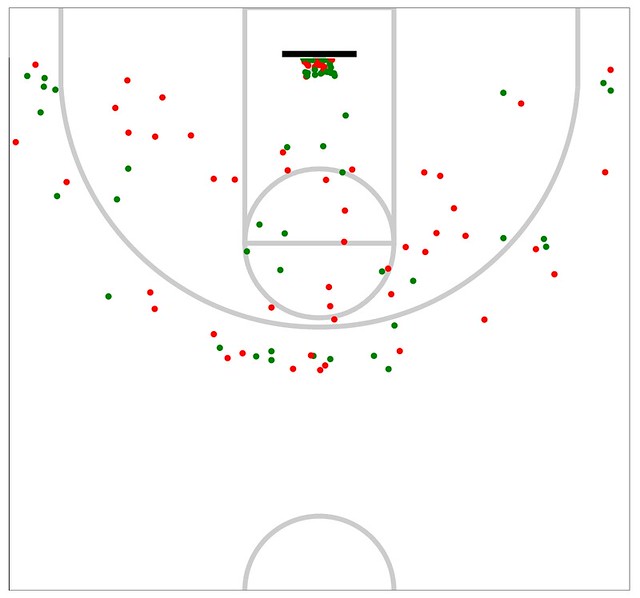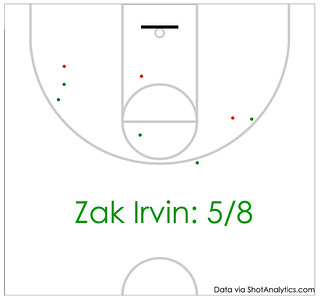You may have noticed, especially during the second half of Monday's thumping of Bucknell, that Michigan's offense has looked a little different this season. This season's shot chart, via Shot Analytics, puts it in picture form (green dots are makes, red misses):

A little over 34% of Michigan's shots this season have come from midrange, compared to just over 25% last season. It's not a good change, either; midrange jumpers are by nature the game's most inefficient, and the Wolverines are hitting just 33% of such shots this season, down from 39% in 2013-14. A higher volume and lower efficiency is obviously not a good thing.
A closer look reveals that there may be something here worth sticking with, however. With the usual sample size caveats applying, here's a simple breakdown of what's working and what's not:


(If you're wondering why it looks like a three is included in Irvin's chart, he had a foot on the line.)
Simply put, Zak Irvin is working, and a look at the tape reveals that this may be no fluke, especially since Irvin wasn't bad on midrange elbow jumpers last season (8/19). Here are all of Irvin's midrange attempts from this season:
He's getting these shots primarily in two ways: catch-and-shoot jumpers (3/3) and step-ins when defenders overplay his outside shot (2/4). The aborted drive to the rim off a curl-cut stands as the exception, not the rule.
[Hit THE JUMP for a look at why the rest of the team isn't shooting like Irvin, as well as a picture pages of how M is getting Irvin good midrange looks.]
Meanwhile, here's a solid sampling of how the rest of the squad is generating these shots. I honed in on Caris LeVert, Derrick Walton, and Kameron Chatman for the clips in this video:
There's one catch-and-shoot in there, and it's probably not a coincidence that's the only midrange jumper Chatman's hit this season (1/6). The rest come off the dribble, and aside from the open Walton pull-up at the elbow, I'm not sure there's a single shot in there really worth taking—even LeVert's little turnaround comes off a drive where taking it up strong and hoping for contact is probably the higher-percentage play. When he takes the same shot from just a couple feet further out in the next clip, it doesn't look like a good idea at all.
It's not a surprise that the non-Irvin guys are struggling from midrange; both LeVert and Walton connected on 33% of those shots last season, usually because they're coming off forays to the hoop that were stymied by good defense. Considering how many of the midrange shots this year are going up with plenty of time left on the shot clock, I'm hoping this is an early-season aberration and/or Beilein allowing his guys to get a feel for those shots in contests Michigan is winning big.
The volume at which LeVert is taking these shots is mildly disconcerting; ideally, he'd be getting to the rim at will against teams like Hillsdale and Bucknell, and instead he's taken eight midrange shots compared to six at the basket. I'm less concerned with Walton, who's 5/6 on shots at the rim; he may be just 1/5 on midrange shots, but between the successful drives and his 4/6 mark from downtown, his shot distribution is looking pretty good.
Michigan's offense should become more efficient as LeVert hones in; he's just 5/14 (36%) on two-pointers this season, compared to 46% on 224 attempts in 2013-14, and that number projected to get better this year with his added bulk—or, at least, remain at the same level while the number of shots rose without Nik Stauskas around as a late-clock wizard. Likewise, Chatman is unlikely to shoot 17% over the course of an entire season; I'd even be willing to bet on that one.
As the offense starts clicking and the freshmen learn their roles, the volume of midrange shots should drop, though with LeVert as the team's #1 option and Chatman taking over for GRIII, it wouldn't surprise if more of those were taken than last season. With that in mind, let's take a lot at one way Michigan was able to generate one of the good long twos—an open catch-and-shoot for Irvin.
Irvin starts in the far corner as M sets up this possession. Walton has the ball at the top of the key as DJ Wilson heads Irvin's way to set what at first appears to be a screen designed for Irvin to curl around towards the free-throw line:

As Irvin's defender (#24) braces himself to also curl around the screen—can't go under a screen against a shooter of Irvin's caliber—Irvin instead makes a hard baseline cut:

The initial baseline cut nearly works on its own, forcing #24 to turn towards the basket and stretch out to prevent an entry pass:

As the defender is recovering, Irvin and Wilson are already working on the next action; Wilson's already turned to set another screen as Irvin doubles back:

The defender gets caught on the pick:

While it looks in real time like #24 makes a solid recovery to get a hand in Irvin's face, it's actually a really clean look:

Zak Irvin doesn't often miss really clean looks:
This was a really nice play, and there were further options. If the center helped out on Irvin with #24 caught on the screen, Irvin could dump it down to Wilson for a dunk; if #24 managed to get past both screens and aggressively contest Irvin's shot, Irvin could put the ball on the floor—you could see #24 hesitate while getting out on the shot for this very reason.
Michigan is creating about the same number of shots at the rim as they did last season, so right now they're replacing high-upside three-pointers with low-efficiency midrange jumpers; that should change as the season goes along—there are too many good passers and three-point shooters on this team for them to be settling for pull-up Js. Zak Irvin's breakout season, however, could in part be fueled by his ability to hit, well, everything, up to and including those difficult long twos.



















